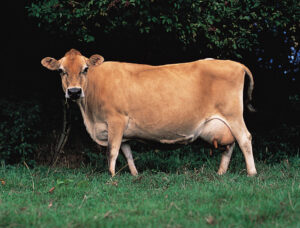Jersey cattle are a breed of dairy cattle that originated from the Channel Island of Jersey, a British Crown dependency off the coast of Normandy, France. Known for their distinctive appearance and high-quality milk production, Jersey cattle have become popular among farmers and dairy enthusiasts around the world.
The History of Jersey Cattle
The history of Jersey cattle can be traced back to the 18th century when they were first bred on the island of Jersey. The breed’s development was influenced by the importation of cattle from France and England, resulting in a unique genetic pool that still exists today.
Jersey cattle were initially bred for their ability to adapt to the island’s rugged terrain and produce high-quality milk. Over time, their reputation for producing rich and creamy milk spread, and they gained recognition as a distinct breed.
Distinctive Characteristics
Jersey cattle are easily distinguishable from other breeds due to their unique physical characteristics. Here are some of the key features:
- Size: Jerseys are relatively small in size compared to other dairy breeds. Adult cows typically weigh between 800 and 1,200 pounds, while bulls can weigh up to 1,800 pounds. Their compact size makes them ideal for small farms or areas with limited grazing space.
- Color: Jerseys have a fawn color, ranging from light tan to dark brown. Some individuals may have white markings on their face, legs, or tail. The distinct coloration adds to their overall appeal and makes them easily recognizable.
- Horns: Unlike some other breeds, Jersey cattle usually have horns. The horns are typically small and curved, adding to their aesthetic appeal. However, in some cases, farmers may choose to dehorn the cattle for safety reasons.
- Body Structure: Jerseys have a well-rounded body with a deep chest and a strong back. Their legs are relatively short but powerful, allowing them to navigate uneven terrain with ease.
Milk Production
One of the primary reasons for the popularity of Jersey cattle is their exceptional milk production. Here are some key points about their milk:
- Butterfat Content: Jersey milk is renowned for its high butterfat content. On average, it contains around 4.84% butterfat, making it ideal for the production of butter, cheese, and other dairy products that require a rich and creamy texture.
- Protein Content: In addition to its high butterfat content, Jersey milk also has a higher protein content compared to milk from other breeds. The increased protein content contributes to its nutritional value and makes it desirable for various dairy products.
- Efficiency: Despite their small size, Jersey cows are highly efficient milk producers. They can convert feed into milk more efficiently compared to larger dairy breeds. This efficiency makes them an economical choice for dairy farmers.
- Milk Yield: While Jersey cows may not produce as much milk as larger dairy breeds like Holsteins, their milk yield is still respectable. On average, a Jersey cow can produce around 13,000 to 16,000 pounds of milk per year.
Temperament and Behavior
Besides their physical characteristics and milk production, Jersey cattle are known for their docile temperament and friendly behavior. Here are some notable traits:
- Gentle Nature: Jerseys are generally calm and easy to handle, making them suitable for small farms or beginners in the dairy industry. Their gentle nature makes them less prone to aggressive behavior, reducing the risk of accidents during handling.
- Social Animals: Jersey cattle are social animals that thrive when they have companionship. They enjoy being part of a herd and interact well with other cows. Providing them with a social environment can contribute to their overall well-being and productivity.
- Curiosity: Jerseys are naturally curious animals and often display a keen interest in their surroundings. This curiosity can make them more adaptable to new environments and less prone to stress or anxiety.
- Foraging Ability: Due to their small size and agility, Jersey cattle are excellent foragers. They can efficiently graze on a variety of grasses and vegetation, making them well-suited for areas with diverse forage options.
Health and Longevity
Jersey cattle are generally hardy and resilient, with a few common health issues. Here are some notable points about their health and longevity:
- Heat Tolerance: Jerseys have a higher tolerance for heat compared to some other dairy breeds. Their ability to withstand warm climates makes them suitable for regions with hot summers.
- Ketosis: Like other dairy cattle, Jerseys are prone to ketosis, a metabolic disorder that can occur during the transition period after calving. Proper nutrition and management can help minimize the risk of ketosis and other metabolic disorders.
- Lifespan: With proper care and management, Jersey cattle can have a relatively long lifespan. On average, they can live up to 12 to 15 years, although some individuals have been known to live even longer.
- Genetic Disorders: While not common, Jersey cattle can be carriers of certain genetic disorders. Responsible breeding practices and genetic testing can help minimize the risk of passing on these disorders to future generations.
Conclusion
Jersey cattle are a unique and highly valued breed known for their distinctive appearance, high-quality milk production, and docile temperament. Their compact size, adaptability, and efficiency make them an excellent choice for small farms and areas with limited grazing space. Whether you are a dairy farmer or simply an enthusiast, considering Jersey cattle can be a rewarding and fulfilling experience.
FAQs About Jersey Cattle
1. Are Jersey cattle suitable for small farms?
Yes, Jersey cattle are well-suited for small farms due to their compact size and efficient milk production. They can thrive in areas with limited grazing space.
2. How much milk can a Jersey cow produce?
On average, a Jersey cow can produce around 13,000 to 16,000 pounds of milk per year. While not as high as larger dairy breeds, their milk’s quality and butterfat content make up for the lower yield.
3. Do Jersey cattle require special care or management?
Jersey cattle have similar care requirements to other dairy breeds. Providing them with proper nutrition, regular veterinary care, and a comfortable environment will help ensure their health and well-being.
4. Can Jersey cattle be used for meat production?
While Jersey cattle are primarily bred for their milk production, their meat can also be consumed. However, their smaller size and lower yield make them less popular for beef production compared to dedicated meat breeds.
5. Can Jersey cattle be crossbred with other breeds?
Yes, Jersey cattle can be crossbred with other breeds to produce hybrid offspring with desirable traits. Crossbreeding can be done to improve milk production, size, or adaptability to specific environments.
Summary
Jersey cattle are a unique and valuable breed known for their distinctive appearance, high-quality milk production, and docile temperament. Their compact size, adaptability, and efficiency make them suitable for small farms and areas with limited grazing space. Despite their smaller size, Jersey cows are highly efficient milk producers, converting feed into rich and creamy milk. They have a gentle nature, making them easy to handle and suitable for beginners in the dairy industry. Additionally, Jersey cattle have a higher tolerance for heat, making them adaptable to warm climates. With proper care and management, Jersey cattle can live relatively long lives. Considering the characteristics and benefits of Jersey cattle can be a rewarding choice for dairy farmers and enthusiasts alike.



